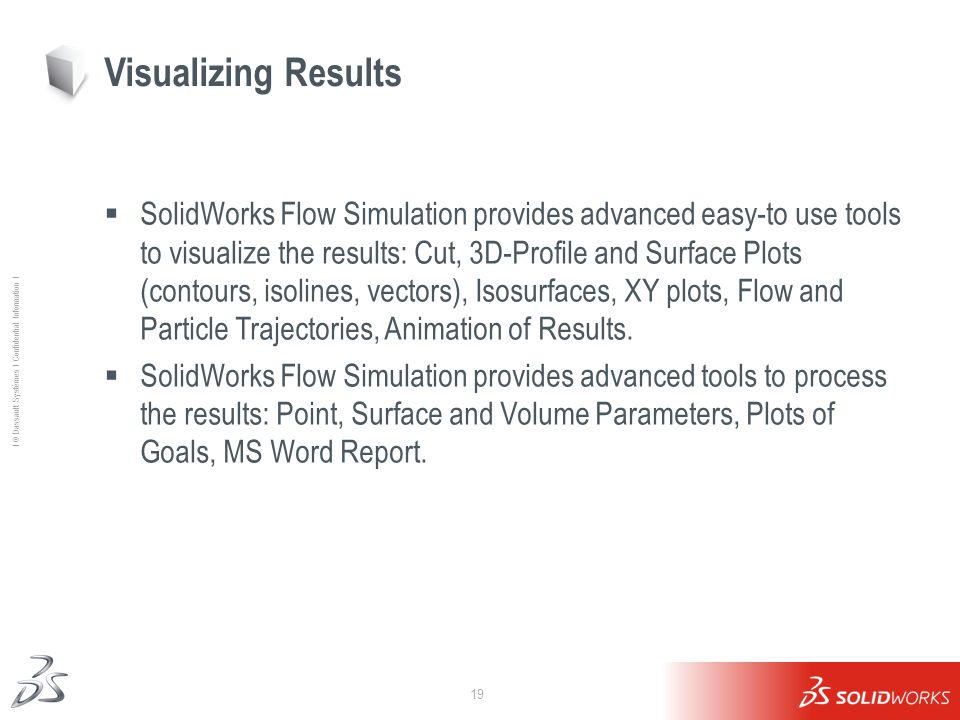
- USING SOLIDWORKS FLOW SIMULATION HOW TO
- USING SOLIDWORKS FLOW SIMULATION MANUAL
- USING SOLIDWORKS FLOW SIMULATION SOFTWARE
- USING SOLIDWORKS FLOW SIMULATION SERIES
In the future blog posts of this series, I will discuss the settings for these different meshing stages. Since we don’t know flow characteristics until enough iterations are solved for the flow to have developed, this takes place during the calculation stage.Įach stage has its own settings.

USING SOLIDWORKS FLOW SIMULATION SOFTWARE
This is when the software refines the mesh based on the flow characteristics taking place in order to accurately capture the flow. Areas of curvature, thin walls, and narrow channels all play into how much the cells get refined. The initial mesh takes software defaults or user input settings related to model geometry and refines the basic mesh around the model geometry.
USING SOLIDWORKS FLOW SIMULATION MANUAL
If using manual settings, typically the number of cells in the x-, y- and z-directions are input by the user to determine the total number of starting cells of the 3D grid. In most cases, it breaks the computational domain into cells that are all equally sized, ignoring model geometry. My goal in this post is to get you to understand the stages of meshing, then in future posts we’ll talk about settings and how those settings affect the mesh at different stages.īasic Mesh is the first mesh made.
USING SOLIDWORKS FLOW SIMULATION SERIES
This post will be the first of a multi-post series addressing the topic. What if you want more accuracy? What if you want more time efficiency from your solution? Well, that’s when you need to become an advanced user and start to use manual settings.Īs I mentioned, meshing in CFD is a large topic.
Engineering database – An enhanced engineering database includes a wide range of building materials and fans so you can do thermal analysis quickly and efficiently.Automatic meshing is done to ensure adequacy for a less-skilled user. Tracer Study – When an admixture substance (such as a contaminant) diffuses in a carrier fluid, you can evaluate the mass fraction of the substance as well as the local Air Quality index (lAQi) and Contaminant removal Effectiveness (CrE) parameters to determine the effectiveness of the ventilation system. These parameters identify where there are problems in thermal comfort level, so you can resolve them before the cooling system is built. Comfort parameters – “Predicted mean vote” (PMV) and “Predicted percent dissatisfied” (PPd) are the two main comfort parameters out of eight calculated by the HVAC Applications Module. Understanding the impact of material choices requires sophisticated radiation modeling that’s included in the HVAC Applications Module. Semitransparent materials (defined as absorptive solid material) are commonly used in the lighting industry and the building industry (glass). Advanced Radiation modeling –Thermal radiation can have a major effect on cooling requirements. Industry-specific tools in the HVAC Applications Module for SOLIDWORKS Flow Simulation give engineers dedicated CFd tools for fluid-flow simulation that are easy to use while providing exceptional simulation power: In this SolidWorks flow simulation tutorial I will tell you how can you find the torque of a wind mill and forces which are acting on its blades due to the effect of air flow by using solidworks flow simulation.  Tracer Study – Analyze the flow of an admixture in an existing carrier fluid to evaluate the effectiveness of a ventilation system in removing contaminant. Human Comfort Factors – The effectiveness of environmental control is measured by eight human comfort factors that evaluate both the reaction of people and the environment.
Tracer Study – Analyze the flow of an admixture in an existing carrier fluid to evaluate the effectiveness of a ventilation system in removing contaminant. Human Comfort Factors – The effectiveness of environmental control is measured by eight human comfort factors that evaluate both the reaction of people and the environment. USING SOLIDWORKS FLOW SIMULATION HOW TO
Product Thermal Design – The HVAC Applications Module simulates airflow in the environment and products used in the environment so you can now analyze products considering real-world behaviors. SolidWorks Aerofoil Calculation Using SolidWorks Flow Simulation to Calculate the Flow Around a NACA5012 Aerofoil Introduction This note explains how to draw an aerofoil in three dimensions in SolidWorks and then how to run a simple calculation of the flow over the geometry. Airflow Optimization – Managing airflow within a large-scale environment ensures that the optimum temperature is maintained for the largest number of people. The module evaluates air and gas movement in working and living environments, as well as thermal radiation, offering advanced radiation modeling, comfort parameters calculation, analysis of admixture (tracer) in a carrier fluid flow, and an enlarged database of materials and fans: 
The HVAC Applications Module for SOLIDWORKS® Flow Simulation enables designers and engineers to quickly and accurately model complex systems for thermal and fluid-flow analysis.







 0 kommentar(er)
0 kommentar(er)
